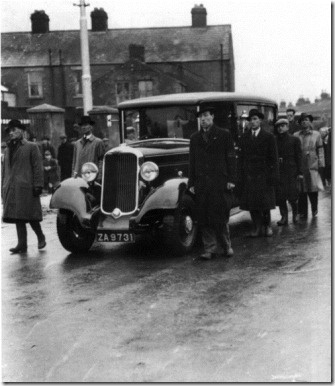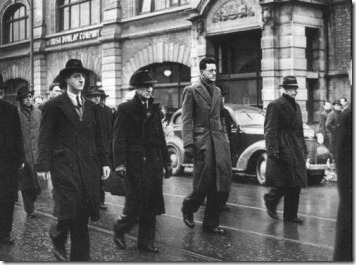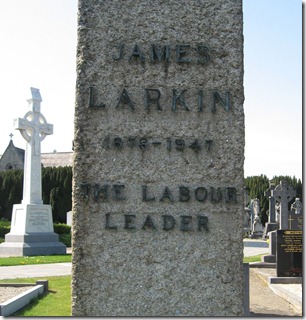“…and that’s not rain on his cheeks”
Jim Larkin’s funeral – February 1947
Having passed away on 30th January, Jim Larkin was buried a few days later, early in February 1947. The report below was penned by Liam MacGabhann and appeared in The Irish Press. It is a wonderfully atmospheric piece of writing, and captures the emotion of the city and its people as Larkin’s funeral procession made its way to Glasnevin cemetery.
Larkin’s sons in Funeral procession
Big Jim Crosses the City
There were crowds at Jim Larkin’s funeral – just as there were crowds in Jim Larkin’s life. A half century of history marched through Dublin yesterday morning. The years were crowded between Haddington Road and Glasnevin.
You couldn’t think of Larkin being in that flower-covered coffin with its Starry Plough flag, just dead. They all came out, men in dungarees with overcoats buttoned up to the throats, marching erectly as he told them to march. It could have been a Citizen-Army-cum-Irish-Volunteer parade, only for the slowness. The very air of the city seemed to be muffled. You had the feeling that the people were magnetised into the funeral ‘as by common instinct’. And the men in the dungarees and the women grown old who have borne children since they struck instinctively at the 400 bosses at Larkin’s will, seemed to be there because they just had to be there. Just because Big Jim was crossing the city. Then you wanted to see a big black slouch hat on the coffin and a big black pipe beside it, because all the time you visualised Larkin swinging his huge shoulders, going to a meeting in the North City. That flag on the Ballast Office symbolised death yet did not stress it. What does it bring back? Words tramp through the slush of the streets, undertones the music of the dead: -
And Connolly watches the ships go out through flags at Kingstown Pier;
A starving Dublin sends its toll of guard and fusilier;
The Citizen Army is out to-day and if you wonder why ,
Go ,ask the lords of the finance boards why the men go out to die.
The south-easterly gale blows up the turbulent river, crashing on the O’Connell Bridge arches like Larkin’s fist at the council table. Boots, heavy and grimy and dirty; boots polished and shiny, tramp, tramp, tramp, joining the long, long crowd, step and slither through the snowy slush. As the procession passes, blinds come down over the windows, people come out of the shops, swell the funeral. Groups that line the sidewalks, waiting, saying nothing, move out, walk after the old grey men of the Citizen Army. Children gather around the huge lorry of flowers, red and yellow and blue and lily white. At Beresford Place the bands cry back through the years. Up from the docks small, stocky men walk. They stand beside the coffin as it halts near Liberty Hall. The deep-sea men seem grimly proud to stand as guard-of-honour. (Larkin…tied to a ship’s stanchion…planning revolution…that’s what you’re thinking.) The parade moves on, by the Workers Union old headquarters. Women on tenement steps-(there are brand new bricks on the buildings now)- hold up children to see the parade. Moladh go deo le Dia ! A Kerry policeman is straightening out the crowd and that’s not rain on his cheeks. Praise be! At Larkin’s funeral I have seen a policeman on duty…crying! Corporation men were cleaning the slush an hour ago .There are men in the funeral with shovels – and they handle them like military weapons. That band rings through the high houses and the words plod by the horses feet-
The Citizen Army is out to-day and if you wonder why,
Go ask the lords of the finance boards if the cash returns are high;
It isn’t the bosses that bear the brunt and ‘tisn’t you or I ,
‘Tis the women and kids whose tears are hid as the Army marches by.
But that is old …out by O’Connell Street you can’t help thinking of Bloody Sunday. Crowds waiting, a D.M.P. man to every two workers and somewhere, silent and disguised, there is hope- Big Jim is crossing the City! So fifty years of history have marched on and so have the D.M.P. Gardai in blue are lining the way for Jim Larkins funeral. There are wreaths on the coffin from people in Britain too, people who wear dungarees- and frock- coats – girls in offices, men in mines. The principal men of the State he helped to build, when the foundation stones were being laid, are behind the great coffin that still looks small because one thinks of the fierce statuary of Big Jim. The Last Post sounds and rifles crash a volley. The people tramp back through the slush and snow, a bit dazed. They seem dimly aware that above the muffled throbbing of the drums, above the lament of the bugle, and the dull thudding of the marching thousands it was really a voice that called them. Larkin’s voice shouting to the people about the history of things they had lost and gained. Like a thousand times before when the battles were won, he had shouted with a proud command in his words: ‘Go back to the Job’. Back to the job…Big Jim has crossed the city.
(From: The Irish Press,5 February,1947)
Jim Larkin’s Grave as it stands today




